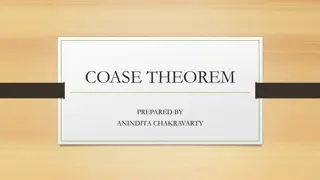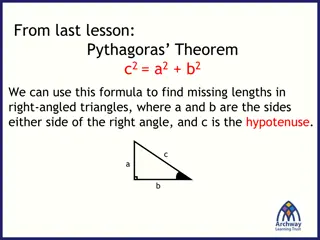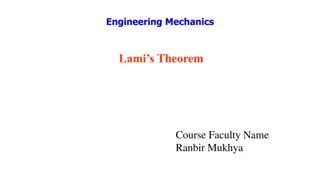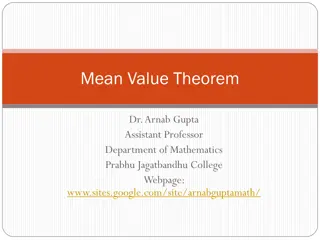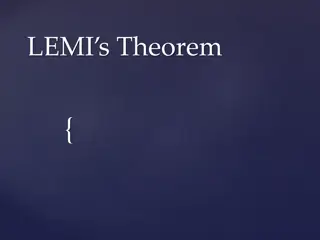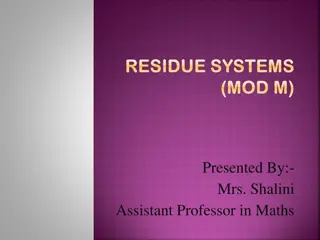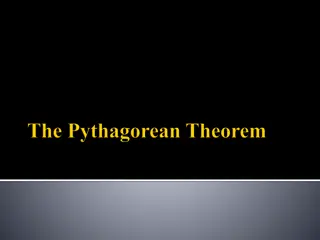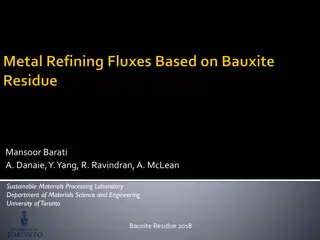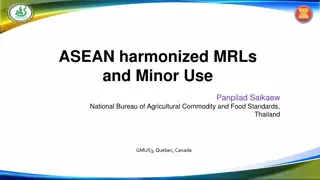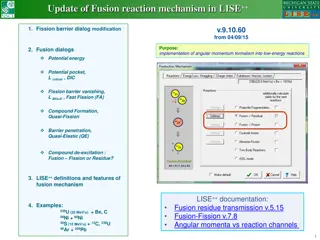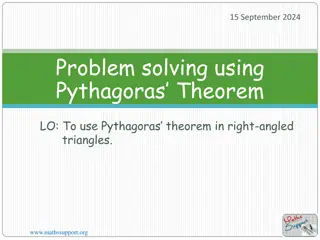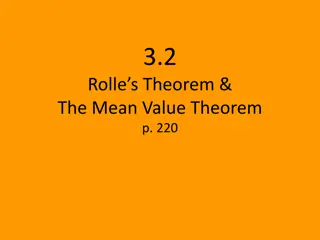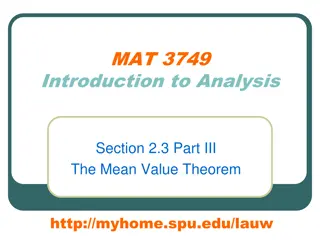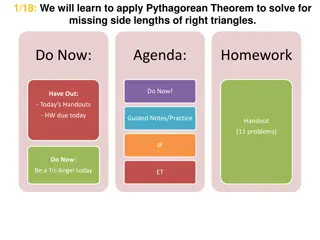Understanding the Residue Theorem in Complex Analysis
The Residue Theorem is a powerful tool in complex analysis that allows us to evaluate line integrals around paths enclosing isolated singularities. By expanding the function in a Laurent series, deforming the contour, and summing residues, we can evaluate these integrals efficiently. This theorem extends to multiple singularities and subsumes Cauchy's Theorem and Integral Formula. The key idea is to identify and sum the residues at singularities to compute the integral value.
Download Presentation

Please find below an Image/Link to download the presentation.
The content on the website is provided AS IS for your information and personal use only. It may not be sold, licensed, or shared on other websites without obtaining consent from the author. Download presentation by click this link. If you encounter any issues during the download, it is possible that the publisher has removed the file from their server.
E N D
Presentation Transcript
ECE 6382 Fall 2023 David R. Jackson Notes 10 The Residue Theorem and Residue Evaluation Notes are from D. R. Wilton, Dept. of ECE 1
The Residue Theorem y C Consider a line integral about a path enclosing an isolated singular point: r 0z x ( ) f z dz = I C The path C stays in a region where f is analytic (except at z0). Expand f (z) in a Laurent series, deform the contour C to a circle of (arbitrary) radius r centered at z0 that stays inside C, and evaluate the integral: 2 ( ) f z dz + + = 1 ( 1) n i n i a r e d n C = n 0 = 0, 1 n = 0 2 ia r 1 ( ) f z ( ) = n 2 ia = a z z 1 0 n = n Note: For a Laurent series we can integrate term-by-term (switch the order of integration and summation) in the region of convergence, due to uniform convergence. i i = Let , , z z re dz rie d 0 2
The Residue Theorem (cont.) The value a-1 corresponding to an isolated singular point z0 is called the residue of f(z) at z0. ( ) f z dz ( ) f z = = 2 Res I i 0 C Note: The path orientation is assumed counterclockwise. Laurent series expansion: a a a ( ) f z ( ) ( ) ( ) 2 3 = + + + + + + + + 3 z 2 z 1 z a a z z a z z a z z ( ) ( ) 0 1 0 2 0 3 0 3 2 z z z 0 0 0 Residue 3
The Residue Theorem (cont.) Extend the theorem to multiple isolated singularities: ( ) n n y ( ) f z dz ( ) f z dz = = 0 f z dz C C C C n n ( ) f z dz ( ) f z dz = C C n n ( ) f z = 2 Res ( ) i each small path sees a single isolated singularity n n ( ) f z = 2 Res i n n The function f is analytic inside this region. y C C C n 4z n C 4 1z C 1 x x C 2z 2 3z C 3 4
The Residue Theorem (cont.) Alternatively, shrink the path, leaving only the singularities encircled: C y C 4 C 1 Isolated singularities atzn x C 2 C 3 ( ) f z dz ( ) f z dz = C C n n ( ) f z = 2 Res ( ) i each small path sees a single isolated singularity n n ( ) f z = 2 Res i n n 5
The Residue Theorem (cont.) Summary of Residue Theorem A function f is an analytic within C except at isolated singularities. y Isolated singularities atzn C z4 z1 x z2 z3 ( ) f z dz ( ) f z = 2 Res i n C n The integral is equal to 2 itimes the sum of the residues at the singularities. Note: The integral is taken counterclockwise. 6
The Residue Theorem (cont.) Note that the residue theorem subsumes several of our earlier results and theorems: Cauchy s Theorem: ( ) ( ) f z = if analytic (no isolated singularities) in 0 Cf z dz C Cauchy Integral Formula: ( ) f z z ( ) f z = i f z if analytic in 2 ( ) dz C 0 z C 0 (Hence is the only isolated singularity in ) . z C 0 ( ) f z z ( ) f z z ( ) f z ( ) ( ) ( ) f z 1 n n = = = = Note: b z z b z z b Residue 0 0 0 0 n n z z = = 0 0 n n 0 0 7
Evaluating Residues Construct Laurent series about each singularity zn, and then identify the coefficient a-1,n= Res f(zn). Sometimes this can be a tedious approach. For a simple pole at z= z0we have a simple formula: a ( ) ( ) = + + + lim z ( ) f z lim z ( ) z z z z a a z z 1 z 0 0 0 1 0 z z z 0 0 0 = a 1 Question: ( ) = Res ( ) f z lim z ( ) f z z z Would this limit exist if it were a higher-order pole? 0 0 z 0 8
Evaluating Residues (cont.) Example: 2 z = = + has simple poles at ( ) f z 2, , z i i + + 2 ( 2)( 1) z z 2 4 5 z ( ( ) = + = Res ( 2) f lim z 2 z z + + 2 ( 2) 1) z 2 2 + 2i 2)2 2 z i ( ) = =( = Res ( ) lim z f i z i ( ) + + 5 i i ( 2)( ) z z i z i i ( 2 ) i 2)( 2 ) + + 2 2 z i ( ) = + =( = Res ( ) lim z f i z i ( ) + + 5 i i ( 2)( ) z z i z i i 9
Evaluating Residues (cont.) Example: 1 = = = has simple poles at ( ) f z , 0, 1, 2, z n n sin z L'Hospital's rule 1 1 ( ) n = = = Res ( ) lim( z n ) lim z 1 f n z n sin cos z z n Alternatively, 1 1 n = = Res ( ) lim( z n ) lim ( z n ) f n z n z n + sin sin( ) z z n 1 + = lim ( z n )sin( z n z n )sin )cos cos( z ) n n z n n ( n w ( ) n = = = since we already know lim z 1 lim w 1 sin( )cos sin z n w 0 n ( ) n f n = Res ( ) 1 10
Evaluating Residues (cont.) The previous rule can be specialized to functions of the form f f(z) = N(z)/D(z), where D(z) has a simple zero at z0: ( ) ( ) N z D z ( ) f z = = , ( ) D z 0, , N D z are analytic at 0 0 ( ) ( ) ( ) 2 = + + Simple zero: ( ) 0 D z a z z a z z a 1 0 2 0 1 ( ) ( ) ( ) ( ) ( ) D z N z D z N z D z N z ( ) f z = = Res = Res lim( z ) lim( z ) z z z z 0 0 0 ( ) ( ) zero D z z z 0 0 0 z 0 ( ) ( ) ( ) D z z N z D z N z = = lim z 0 Question: ( ) ( ( ) ) D z z 0 0 Would this limit exist if it were a higher-order zero? 0 z 0 Hence ( ) ( ) ( ) ( ) N z D z N z D z = Res 0 ( ) = Note: D z a 0 1 0 z 0 11
Evaluating Residues (cont.) ( ) f z Example: = tan z ( ) + 2 1 n sin cos z z = = has simple poles at tan , z z 2 = f or 0, 1, 2, n ( ) + 2 1 n sin ( ) 2 = = Res tan 1 z ( ) + 2 1 n sin 2 ( ) + 2 1 n ( ) = = = Res tan 1, , 0, 1, 2, z z n 2 12
Evaluating Residues (cont.) Including a Multiplying Function ( ) f z ( ) ( ) A z F z = ( ) F z ( ) ( ) = = A z z analytic function at 0 F z z function with simple pole at 0 b ( ) ( ) ( ) ( ) ( ) = = = + + + Res ( ) f z lim z ( ) f z lim z ( ) lim z ( ) z z z z A z F z z z A z 1 z b b z z 0 0 0 0 0 1 0 z z z z 0 0 0 0 ( ) ( ) = + + lim ( ) z z A z b A z b b z z 1 0 0 0 = ( ) 0 1 Hence, we have: ( ) F z = Res ( ) f z ( )Res A z 0 0 0 13
Evaluating Residues (cont.) For a non-simple pole of finite order m at z= z0: Atthe pole, the Laurent series is a a a = + + + + + + + 2 + ( ) f z ( ) ( ) 1 ) m z m z 1 z a a z z a z z 0 1 0 2 0 1 m m ( ) ( ( ) z z z 0 0 0 Hence the following series is a Taylor series about the pole: = + + + + + 1 m m m ( ) ( ) f z ( ) ( ) ( ) z z a a z z a z z a z z + 0 1 0 1 0 0 0 m m 1 m A formula for th e coefficent of is ( ) z z Example (m = 3): 0 1 m 1 d dz ( ) ( ) f z ( ) 3 = + z z a a z z = m ( ) ( ) f z a z z 0 3 2 0 ( ) 1 0 1 m 1 ! ( ) ( ) m 2 3 + + + a z z a z z z z = 1 0 0 0 0 1 m 1 d dz = m finite) Res ( ) f z ( ) ( ) f z ( z z m ( ) 0 0 1 m 1 ! m z z = 0 14
Evaluating Residues (cont.) A test to find the order m of a pole: For a non-simple pole of finite order m at z= z0: = a p m m m , m ( ) p = = lim z ( ) f z 0, L z z p p 0 z 0 , Proof: a a a = + + + + + + + 2 + ( ) f z ( ) ( ) 1 ) m z m z 1 z a a z z a z z 0 1 0 2 0 1 m m ( ) ( ( ) z z z 0 0 0 a 0 where m p m p m + = + + + + + 1 1 p p p ( ) ( ) f z ( ) ( ) ( ) ( ) z z a z z a z z a z z a z z + 0 0 1 0 1 0 0 0 m m 15
Evaluating Residues (cont.) 1 m 1 d dz = m finite) Res ( ) f z ( ) ( ) f z ( z z m ( ) 0 0 1 m 1 ! m z z = 0 Example: + 2 2 ( z z = = has a pole of order 3 at ( ) f z 2 z + 3 2) z + 2 2 1 2! 2 ( d dz z z = + 3 Res ( 2) f ( 2) z 2 + 3 2) z = 2 z 2 1 2! 4 2! d dz = + = = 2 2 2 z z 2 = 2 z Res ( 2) f = 2 16
Evaluating Residues (cont.) Example: 1 = = = has poles of o de r r at ( ) f z 2 , 0, 1, 2, z n n 2 sin z )sin ) sin cos 2 2 2 1 1! ( ) 2( 2( d dz z n z n z z n z z = = Res ( ) f n 2 4 sin sin z z = = z n z n = )sin ) cos 2 2( 2( z n z z n z = 3 sin z z n After three applications of L Hospital s rule: f n = Res ( ) 0 17
Evaluating Residues (cont.) Alternative calculation: 1 1 n 1 z 1 ( ) = = = = = ( ) f z u z n + 2 2 2 2 sin sin ( 1 ) sin ( ) sin z z n n u 1 = = 2 2 Note: 3 5 2 4 u u u u + + 2 A simple shift does not affect the residue (we have the same coefficients in the Laurent series) 1 u u 3! 5! 3! 5! 2 Geometric Series 2 2 4 6 2 4 6 1 u u u u u u u = + + + + + 1 2 3! 5! 7! 3! 5! 7! 2 2 1 u 1 5! 1 1 u 2 3 u = + + + + = + + 4 1 u ( ) 3! 2 2 2 3! ! a missing term Residue=0 1 u f n = Res ( ) 0 18
Evaluating Residues (cont.) Example: = 1/ z ( ) f z e (essential singularity at z = 0) 2 3 1 z 1 2! 1 z 1 1 3! = + + + + 1/ z 1 e z a = 1 Residue: 1 = Res (0) 1 f 19
Evaluating Residues (cont.) Summary of Residue Formulas ( ) = Res ( ) f z lim z ( ) f z z z Simple pole 0 0 z 0 = ( ) ( ) ( ) ( ) N z D z N z D z ( ) = if Res ( ) D z 0 0 simple zero Simple pole 0 0 1 m 1 d dz = m Res ( ) f z lim z ( ) ( ) f z z z Pole of order m ( ) 0 0 1 m 1 ! m z 0 20
Evaluating Residues (cont.) Extension for simple poles (going halfway around) Note: y If it is not a simple pole, the integral around the small semicircle may tend to infinity. We go halfway around on an infinitesimal semicircle. x 0z C e = i z z 0 As 0: ( ) f z dz ( ) f z Res i 0 0 C Proof: 0 0 i e i a dz ( ) = = = = Residue term: dz a a d a id a i 1 z 1 1 1 1 i z z z e 0 0 C C 0 ( ) ( ) Note: For n < -1 the integral does not converge! n + 1 i n + = 1 n For 1: 0 n a z z dz ia e d 0 n n C 21
Evaluating Residues (cont.) Extension for simple poles (going halfway around) Similarly, if we go in the opposite direction: y C Clockwise x 0z As 0: ( ) f z dz ( ) f z Res i 0 0 C 22
Numerical Evaluation of Residues Here we assume a simple pole at z0. y ( ) = + z z z = Res ( ) f z lim z = ( ) f z z z 0 0 0 ) z z z 0 ( + Let z z z z z 0z 0 0 x Therefore, we have z = sample point + Res ( ) f z ( ) z f z z 0 0 Examine the error using a Laurent series: a ( ) ( ) 2 = + = + + + + ( ) f z ( ) 1 z f z z a a z z a z z 0 0 1 0 2 0 z a 0 ( ) ( ) 2 = + + + + 1 z a a z a z 0 1 2 ( ) ( ) 2 z f z + = + + + ( ) z a a z a z 0 1 0 1 Error Error z 23
Numerical Evaluation of Residues (cont.) We can improve this by using two sample points and averaging: z f z + + + ( ) ( ) z z f z z Res ( ) f z 1 0 1 2 0 2 + 0z z 0 2 z y 0z = = Choose , z z z z 1 2 0z z x + ( ) ( ) f z z f z z Res ( ) f z z 0 0 0 2 This is a central-difference formula. 24
Numerical Evaluation of Residues (cont.) Examine the error using a Laurent series: + ( ) ( ) f z z f z z + 0z z Res ( ) f z z 0 0 z y 0 2 0z 0z z x a ( ) 2 + = + + a z + + ( ) f z z a a z 1 0 0 1 2 z a ( ) ( ) 2 = + + + + ( ) f z z a a z a z 1 0 0 1 2 z + ( ) ( ) f z z f z z ( ) 2 = + + z a a z 0 0 1 1 2 Error 2 Error z 25
Numerical Evaluation of Residues (cont.) We can improve this even more by using four sample points: 2 /2 2 /2 3 /2 3 /2 z f z + + + + + + + /2 /2 i i i i i i ( ) ( ) ( ) ( ) z ze f z e z ze f z e z ze f z e z Res ( ) f z 0 0 0 0 0 4 2 /2 3 /2 = = = = /2 i i i , , , z z z ze z ze z ze + /2 i z e z 1 2 3 4 0 + 0z z y Examine the error using a Laurent series: z 0z a ( ) ( ) ( ) 2 3 3 /2 + + = + + + + + i z e z ( ) f z z 1 z a a z a z a z 2 /2 + i z e z 0 0 0 1 2 3 0 x a ze ( ) ( ) ( ) 2 3 + = + + + + + /2 /2 /2 /2 i i i i ( ) f z ze a a ze a ze a ze 1 i 0 0 1 2 3 /2 a ( ) ( ) ( ) 2 3 2 /2 2 /2 2 /2 2 /2 + = + + + + + i i i i ( ) f z ze 1 2 /2 a a ze a ze a ze 0 0 1 2 3 i ze a ze ( ) ( ) ( ) 2 3 3 /2 3 /2 3 /2 + = + + + + + 3 /2 i i i i ( ) f z ze 1 3 /2 a a ze a ze a ze 0 0 1 2 3 i We see that 2 /2 2 /2 3 /2 3 /2 + + + + + + + /2 /2 i i i i i i ( ) ( ) ( ) ( ) f z z e f z e z e f z e z e f z e z ( ) 4 = + + z a a z 0 0 0 0 1 3 4 4 Error z 26
Numerical Evaluation of Residues (cont.) A little more detail: a ( ) ( ) 2 3 + = + + a z + + + ( ) f z z 1 z a a z a z 0 0 1 2 3 a ( ) ) ( ) ) ( ) 2 3 4 ( ( 2 3 + = + + a z e + + + /2 /2 /2 /2 /2 /2 i i i i i i ( ) e f z ze 1 z a e a z e a z e 0 0 1 2 3 a a ( ) ) ( ) ) ( ) 2 3 4 ( ( 2 3 2 /2 2 /2 2 /2 2 /2 2 /2 2 /2 + = + + a z e + + + i i i i i i ( ) e f z ze 1 z a e a z e a z e 0 0 1 2 3 ( ) ) ( ) ) ( ) 2 3 4 ( ( 2 3 3 /2 3 /2 3 /2 3 /2 3 /2 3 /2 + = + + a z e + + + i i i i i i ( ) e f z ze 1 z a e a z e a z e 0 0 1 2 3 Simplifying: a ( ) 1 ( )( ) 1 ( ) ( ) ( ) ( ) 2 3 + = + + + + + ( ) 1 1 f z z 1 z a a z a z a z 0 0 1 2 3 a ( ) ( )( ) ( ) ( ) ( ) ( ) 2 3 + = + + + + + /2 /2 i i ( ) 1 1 e f z ze 1 z a i a z a z i a z 0 0 1 2 3 a ( ) ( )( ) 1 ( ) ( ) ( ) ( ) 2 3 2 /2 2 /2 + = + + + + + i i ( ) 1 1 1 e f z ze 1 z a a z a z a z 0 0 1 2 3 a ( ) ( )( ) ( ) ( ) ( ) ( ) 2 3 3 /2 3 /2 + = + + + + + i i ( ) 1 1 e f z ze 1 z a i a z a z i a z 0 0 1 2 3 27
Numerical Evaluation of Residues (cont.) In general, we can use N sample points ( ) 2 1 /, i n N = = 1,2 nz ze n N ( ) ( ) N 1 N ( ) ( ) 1 / 1 / 2 2 i n N i n N + Res ( ) f z ze f z e z 2 / + i N z e z 0 0 0 + 0z z = 1 n y z 0z N Error z x N = 8 28
Numerical Evaluation of Residues (cont.) We can also numerically integrate around a simple pole: 1 ( ) f z dz = Res ( ) f z 0 2 i C C y r Choose a small circle of radius r: z z = = 0z + i re 0 ire d x i dz 2 r ( ) = + i i Res ( ) f z f z re e d 0 0 2 1 0 N Use the midpoint rule of integration: 0 2 2 N = 2 N 1 2 Sample points: = = , 1,2 n n N n N intervals 29
Numerical Evaluation of Residues (cont.) We then have 0 1 N 2 r ( ) = + i i Res ( ) f z f z re e d 0 2 0 0 2 0 2 N = Sample 2 N 1 2 = = , 1,2 n n N n ( ) N 2 N r ( ) ( ) 1/2 / 1/2 / 2 2 i n N i n N + Res ( ) f z f z re e 0 0 2 = 1 n or / i N ( ) N re ( ) n N n N + 2 / / 2 / i i N i Res ( ) f z f z r e e e 0 0 N = 1 n or z N ( ) n N n N + 2 / 2 / i i / i N Res ( ) f z 0 f z z e e z re where 0 0 0 0 N = 1 n 30
Numerical Evaluation of Residues (cont.) We then have 1 N N ( ) ( f z ) n N n N z e + 2 / 2 / i i Res ( ) f z z e 0 0 0 0 = 1 n or ( ) ( ) N 1 N (We have the same set of sample points if n is replaced by n-1.) ( ) ( ) 1 / 1 / 2 2 i n N i n N + Res ( ) f z ze f z ze 0 0 = 1 n This is the same result that we obtained from the sampling method! Note: The midpoint rule is exceptionally accurate when applied to a smooth periodic function, integrating over a period*. *J. A. C. Wiedeman, Numerical Integration of Periodic Functions: A Few Examples, The Mathematical Association of America, vol. 109, Jan. 2002, pp. 21-36. 31




